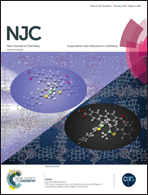Cyanide-bridged heterobimetallic magnetic complexes based on metalloporphyrinate and tricyanometalate building blocks†
Abstract
Three cyanide-bridged metalloporphyrinate complexes with the formula {[(Tp*)Fe(CN)3]2[Mn(TPP)]}[Mn(TPP)(MeOH)2] (1), {[(Tp)Cr(CN)3]2[Mn(TPP)]}[Mn(TPP)(MeOH)2] (2), and {[(Tp*)Fe(CN)3][Mn(TPyP)]}n (3) (Tp*− = hydrotris(3,5-dimethylpyrazol-1-yl)borate, Tp− = tris(pyrazolyl)hydroborate, TPP2− = tetra(phenyl)porphyrinate, and TPyP2− = tetra(4-pyridyl)porphyrinate) have been first synthesized based on tricyanometalate building blocks and metalloporphyrinate precursors. The crystal structures show that complexes 1 and 2 possess similar sandwich-like molecular structures composed of an anionic trimer and a cationic monomer. More interestingly, the introduction of manganese tetra(4-pyridyl)porphyrinate precursor results into the formation of an unprecedented neutral one-dimensional zigzag single chain complex 3. Variable temperature dc magnetic measurements reveal the ferromagnetic and antiferromagnetic interaction between MnIII and FeIII centers for complexes 1 and 3, respectively, and antiferromagnetic coupling between CrIII and MnIII centers for complex 2. While ac magnetic susceptibility measurements mainifest that only complex 3 shows the slow magnetic relaxation behavior of a single-molecule magnet.


 Please wait while we load your content...
Please wait while we load your content...